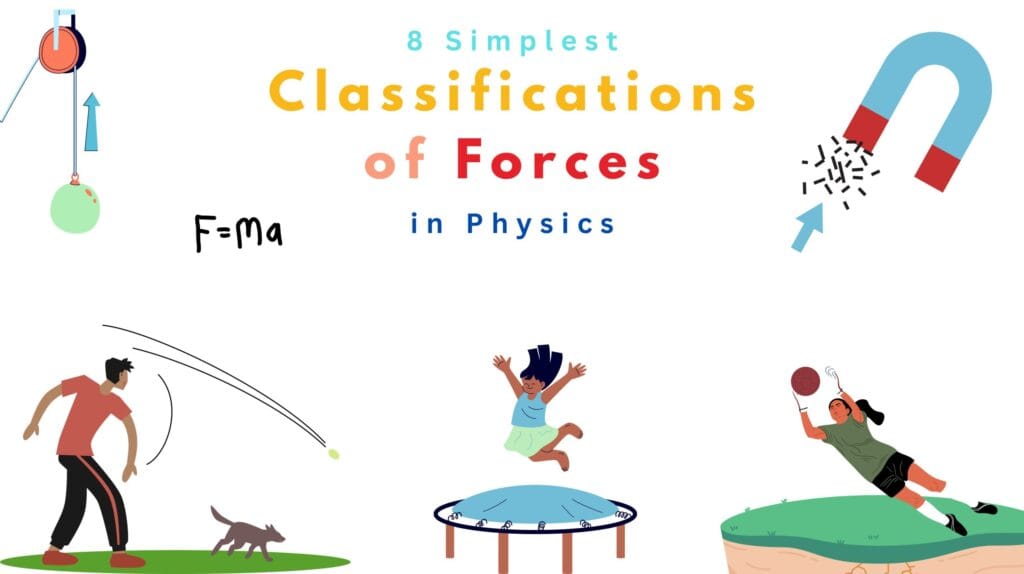Based on the chosen criteria, there are different classifications of forces in physics. Here you will see 8 ways to classify forces.
Table of Contents
Introduction
“Pushing, Pulling, Resisting, or Attracting — Forces are Everywhere.”
Previously, you explored the definition of force, its effects, and its historical background. Now, we dive deeper to answer a crucial question:
How many types of forces are there, and how can they be categorised?
Classifications of Forces
Forces can be classified in multiple ways. Below are 8 of the most useful and simple classifications of forces.
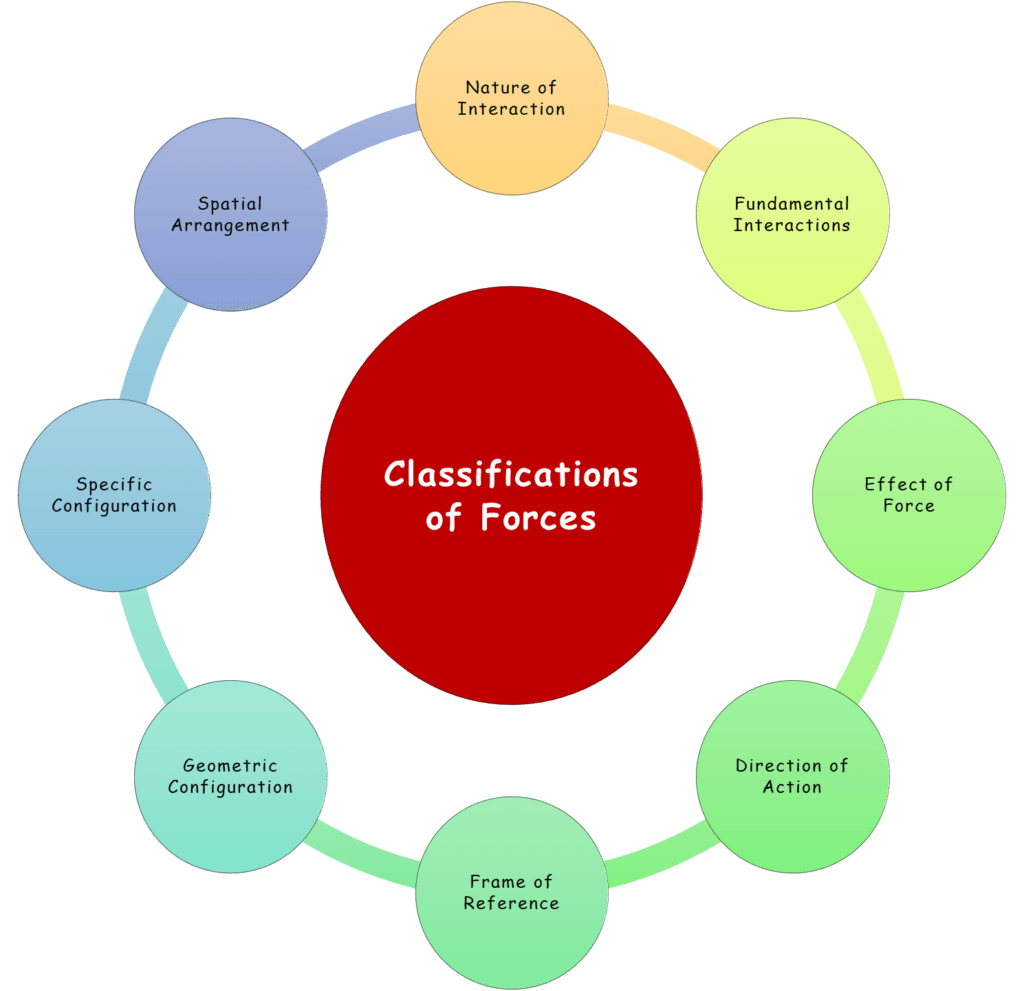
1. Based on the Nature of Interaction
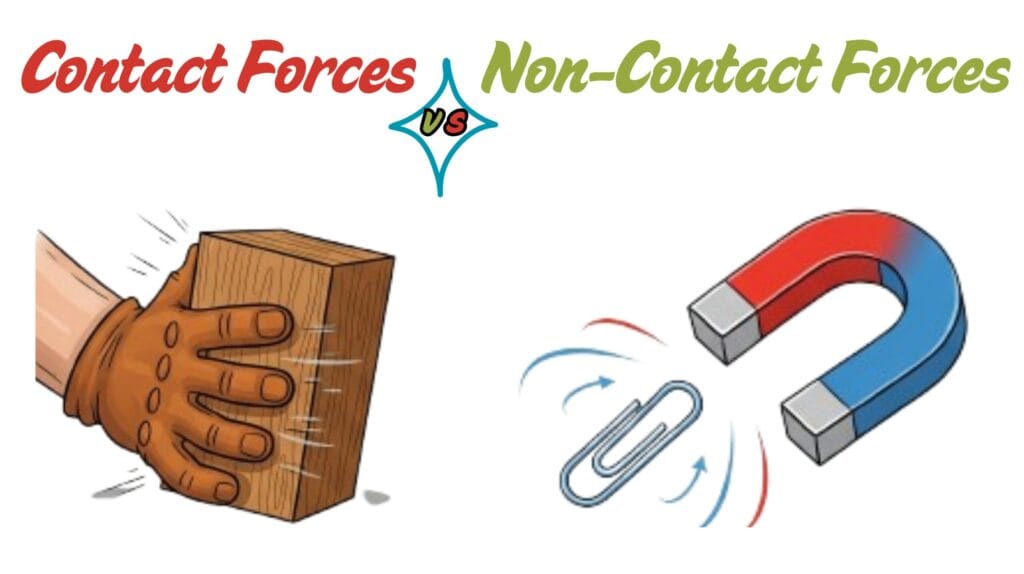
Contact Forces
These forces require physical contact between two objects. These forces could be the result of an action or a reaction.
The 6 main contact forces are given here.
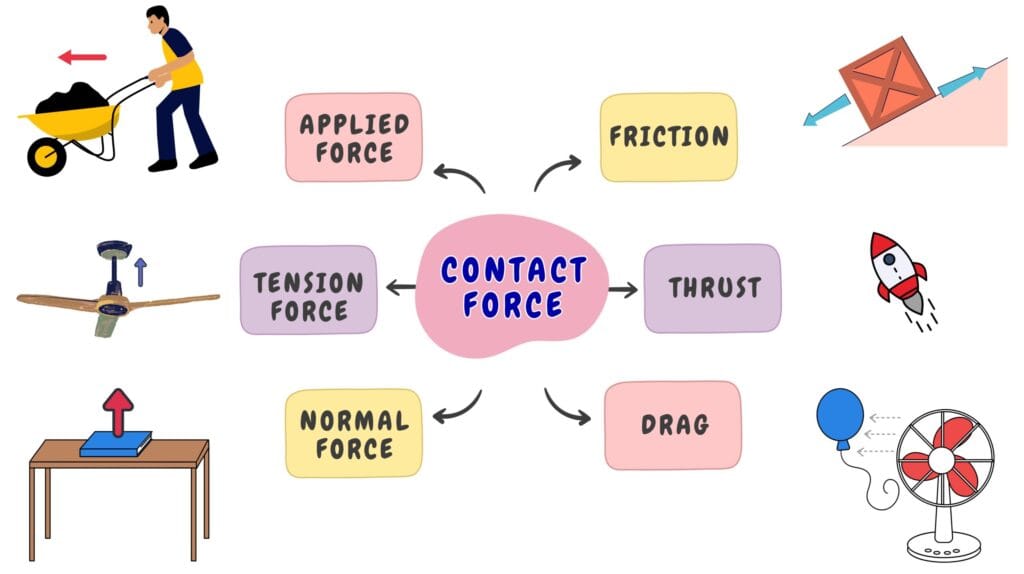
i. Applied Force
A direct force exerted by an external agent. For instance, holding and raising a glass of water.
ii. Tension Force
A force transmitted through a string, rope, or cable when pulled tight. For instance, a ceiling fan or a swing.
iii. Normal Force
The perpendicular reaction force exerted by a surface to support an object resting on it. For instance, a book lying on a table.
iv. Frictional Force
A resistive force that opposes relative motion between two surfaces in contact. For instance, a sliding box on a slope or a person walking
v. Thrust
A force that moves an object forward or upward and is typically produced by expelling mass. For instance, jet engines or rockets.
vi. Drag
A resistive force opposing motion through a fluid (gas and/or liquid). It is a general term encompassing both air and water resistance.
- Air Resistance
A type of friction experienced by objects moving through air. For instance, a descending parachutist or a falling apple.
- Water Resistance
Similar to air resistance, it is a resistive force but occurs in liquids, particularly water. For instance, a ship moving on the water or a swimming fish.
Non-Contact Forces
These forces act at a distance, without any physical contact. They are also called action-at-a-distance forces or field forces because they occur through fields.
These forces are always present regardless of whether the interacting objects are touching or not.
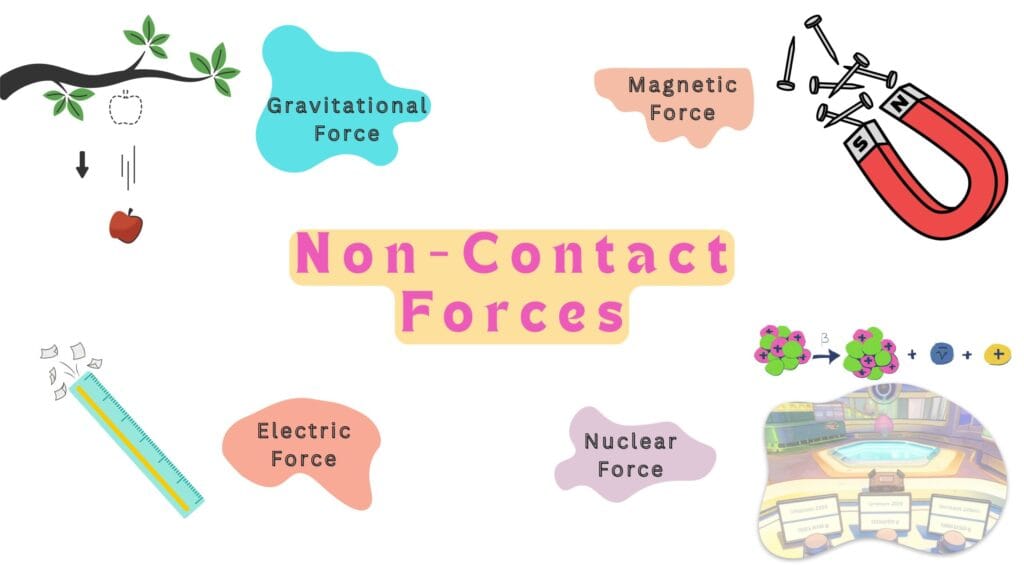
i. Gravitational Force
This is the attractive force that exists between two objects with mass.
Force Field
Every mass creates a field around it and is termed a gravitational field. Other masses within this field experience a force called the gravitational force. This force is directed toward the mass.
Real–world Examples
- Ocean tides – caused by the Moon-Earth gravity interaction
- Satellite motion around Earth
- Free-fall acceleration
ii. Electrostatic Force
It is a force that acts between charged particles. The force can be:
- Repulsive (for like charges, positive–positive or negative–negative).
- Attractive (for unlike/opposite charges, positive–negative).
Force Field
A charged object generates an electric field around it. The strength and direction of the field determine how other charges react in its presence.
Real–World Examples
- Lightning strikes are a build-up of static charges in clouds.
- A charged comb attracts tiny pieces of paper.
iii. Magnetic Force
This force acts between magnetic poles or moving electric charges. The force can be of two types, depending upon the polarity of the magnetic poles (or the moving charges).
- Repulsive (North–North or South–South)
- Attractive (North–South)
Force Field
A magnetic field is a force field produced by permanent magnets or moving charges (currents). It is represented by lines going from the North Pole to the South Pole externally.
Real–World Examples
- Compass aligns with the magnetic field of the Earth
- MRI machines using strong magnetic fields
- Maglev (magnetic levitation trains)
iv. Nuclear Forces
The nuclear forces are the atomic and subatomic forces that operate without physical contact between particles.
They function via exchange of force-carrying particles (gluons, W/Z bosons).
Both strong and weak nuclear forces are non-contact forces. However, traditionally, these are not grouped under “non-contact” forces in high school. These are mainly studied under nuclear physics or particle physics modules.
Key Differences between Contact Force vs Non-Contact Force
| Feature | Contact Force | Non-Contact Force |
| Physical contact | Required | Not required |
| Medium | Requires a material interface | Acts through a field (space) |
| Examples | Friction, Tension | Gravity, Magnetism, Electrostatics |
| Action Range | Short-range | Long or very short (nuclear) |
Important Notes
- Non-contact forces are field-based and belong to the 4 forces of nature.
- Field lines are the lines around the object where its influence (force) is felt.
- The force vector shows the direction and strength of the force acting on a test object in the field.
2. Based on Fundamental Interactions
All physical interactions in the universe are governed by four fundamental forces.
These are the foundational “rules of engagement” for all matter and energy. Even complex or everyday forces (like friction or tension) are ultimately rooted in these four.
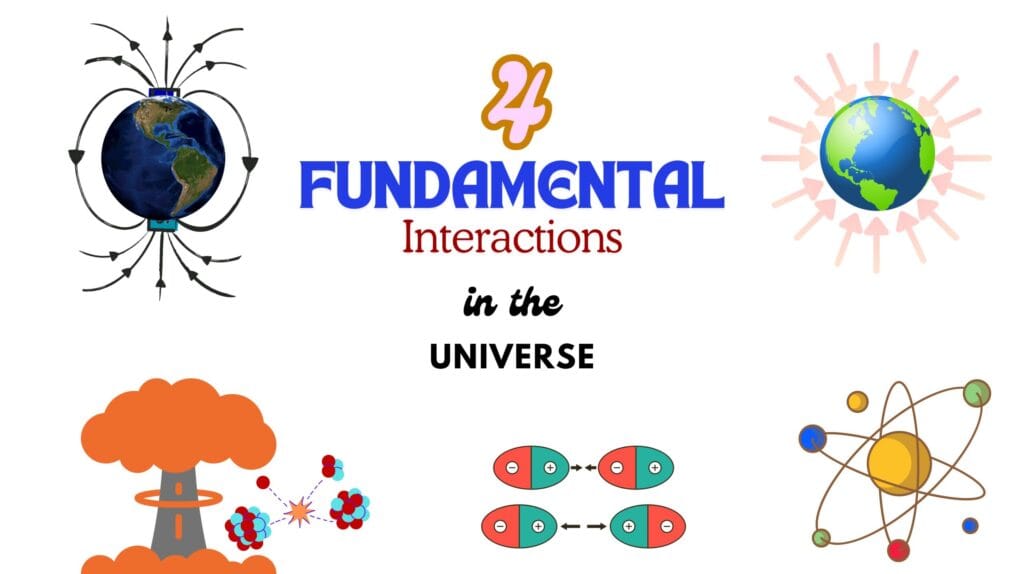
Here is a comprehensive comparison among the four fundamental interactions: gravitational force, electromagnetic force, strong nuclear force, and weak nuclear force.
| Attribute | Gravitational | Electromagnetic | Strong Nuclear | Weak Nuclear |
| Definition | Attraction between objects with mass | Acts between electrically charged particles | Binds protons and neutrons inside atomic nuclei | Causes certain types of radioactive decay |
| Nature | Always attractive; governs large-scale structures and motion | Can be attractive or repulsive; governs most everyday forces | Always attractive; overcomes proton repulsion; holds nuclei together | Enables particle transformation; changes quark type; weak and short-range |
| Mathematical Expression | No simple expression at the macroscopic scale | No simple expression at the macroscopic scale | ||
| Relative Strength | ||||
| Range | Infinite | Infinite | Very short (~10⁻¹⁵ m) | Extremely short (~10⁻¹⁸ m) |
| Key Features | ‣ Always attractive ‣ Weakest force but dominates at the cosmic scale ‣ Acts over infinite distances ‣ Governs cosmic structures | ‣ Can attract or repel ‣ Much stronger than gravity ‣ Governs most everyday phenomena ‣ Long-range force | ‣ Strongest force ‣ Acts only within nuclei ‣ Overcomes proton repulsion ‣ Essential for atoms | ‣ Weak but essential ‣ Enables decay and transformation ‣ Only force to change quark type ‣ Crucial in stars |
| Examples | • Apple falling from a tree • Moon orbiting Earth • Tidal forces on oceans | • Balloon sticking to hair • Magnetic attraction/repulsion • Electric current in a wire | • Stability of the helium nucleus • Nuclear fusion in stars | • Beta decay (neutron → proton + electron + antineutrino) • Nuclear reactions in the Sun |
Electroweak Unification
At extremely high energies, such as those present in the early universe, the electromagnetic force and weak nuclear force merge into a single force. This phenomenon is called electroweak unification.
For the ground-breaking achievement, Dr. Abd-ul-Salam, Sheldon Glashow, and Steven Weinberg earned the Nobel Prize in Physics in 1979.
3. Based on the Effect of Force
| Attribute | Balanced Forces | Unbalanced Forces |
| Definition | Equal in magnitude and opposite in direction. | Unequal magnitude and do not cancel each other out. |
| Nature | Cancel each other out; result in no change in motion. | Causes acceleration or change in motion due to a net force. |
| Examples | • Tug-of-war at a draw • Book on a table (normal force balances gravity) | • Pushing a stationary box • A moving car speeding up or slowing down |
4. Based on Direction of Action
| Attribute | Centripetal Force | Centrifugal Force |
| Definition | A force directed toward the centre of a circular path. | An apparent outward force in a rotating frame of reference. |
| Nature | Keeps an object in circular motion; acts perpendicular to velocity. | Not a real force; it arises due to inertia in non-inertial frames. |
| Examples | • Tension in circular motion • Planetary orbits | • Outward push felt in a turning vehicle • Sliding outward on a spinning ride |
5. Based on the Frame of Reference
| Attribute | Real Force | Pseudo-Force |
| Definition | Arise from actual physical interactions like gravity, contact, or friction. | Appear only in accelerating or rotating (non-inertial) frames. |
| Nature | Obey Newton’s laws and are present in all frames of reference. | Not an actual force; they arise due to the acceleration of the reference frame. |
| Examples | • Gravitational force • Tension • Friction | • Centrifugal force • Coriolis force |
6. Based on Geometric Configuration
| Attribute | Perpendicular Forces | Inclined Forces | Parallel Forces |
| Definition | Act at 90° angles to each other. | Act at oblique angles to a reference surface or direction. | Act in the same or opposite direction along the same line or plane. |
| Nature | Useful for breaking a force into components, especially in surface analysis. | Typically resolved into horizontal and vertical components using trigonometry. | May be balanced or unbalanced; contribute directly to linear motion or equilibrium. |
| Examples | • Normal force and gravity • Perpendicular electric/magnetic fields | • Pushing a cart at an angle • Gravity on an inclined plane | • Two people pushing a cart • Gravity and tension in vertical motion |
7. Based on Specific Configurations
| Attribute | Concurrent Force | Non-Concurrent Force |
| Definition | Force that meet or act through a single point. | Forces that do not meet at a single point. |
| Nature | Can be added using vector laws, common in equilibrium problems. | Typically involve torque and require moment or rotational analysis. |
| Examples | • Strings meeting at a knot • Loads on a crane joint | • Forces on a beam with supports • Frame structures in buildings |
8. Based on the Spatial Arrangement of Forces
| Attribute | Coplanar Force | Non-Coplanar Force |
| Definition | Force that lie and act within the same geometric plane. | Force that act in different planes or directions in 3D space. |
| Nature | Problems can be analysed using 2D vector resolution. | Require full 3D vector analysis, common in complex mechanical systems. |
| Examples | • Drifting a car on a flat road • Pulling a table from all sides | • Forces on aircraft components • Structural forces in 3D frame assemblies |
Conclusion
Forces shape how objects move and interact. By classifying them into 8 simple types, you can better understand various physical phenomena. These categories help simplify complex motions and structural interactions.
Mastering them builds a solid foundation for studying motion, mechanics, and real-world applications in science and engineering.
Frequently Asked Questions (FAQs)
Write about possible criteria for classifications of forces in physics.
Forces can be classified based on:
- Direction of action (Centripetal vs Centrifugal)
- Effect on objects (Balanced vs Unbalanced)
- Frame of reference (Real Force vs Pseudo-force)
- Fundamental interactions (Gravitational, Electromagnetic, Strong Nuclear, Weak Nuclear)
- Geometric configuration (Perpendicular, Inclined, Parallel)
- Nature of interaction (Contact vs Non-Contact)
- Spatial arrangement (Coplanar vs Non-coplanar)
- Specific configuration (Concurrent vs Non-concurrent)
What are 5 examples of contact force?
- A hanging swing (Tension Force)
- A book on a table (Normal Force)
- Pushing a shopping cart (Applied Force)
- A sled sliding on snow (Frictional Force)
- A rocket launching upward (Thrust Force)
What is a non-contact force?
It is a force that acts without physical contact, such as gravity, magnetism, or electrostatic force.
What is the strongest fundamental force?
The strong nuclear force is the strongest fundamental force and holds atomic nuclei together.
What is a balanced force?
Balanced force(s) cancel each other out and do not cause motion or change in velocity.
What is the difference between real and pseudo-forces?
Real force arise from physical interactions; pseudo-force appear only in accelerating or rotating (non-inertial) frames.
Why is friction important in daily life?
Friction enables walking, driving, writing, and gripping objects—it prevents slipping and uncontrolled motion.
What is the role of centripetal force?
It keeps an object moving in a circular path by pulling it toward the centre.
Can a force exist without motion?
Yes!
A force can be applied without causing motion if it’s balanced by another force (e.g., a book resting on a table).

